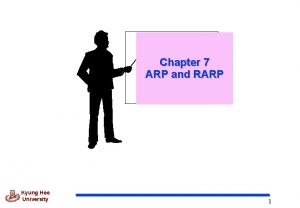Lecture Week 7 Encapsulation Msury Mahunnah Encapsulation n










- Slides: 10

Lecture Week 7 Encapsulation Msury Mahunnah

Encapsulation n We can take one of two views of an object: n Internal – the details of the variables and methods of the class that defines it. n External – the services that an object provides and how the object interacts with the rest of the system. n From the external view, an object is an encapsulated entity, providing a set of specific services. n These services define the interface to the object.

Encapsulation n One object (called the client) may use another object for the services it provides. n The client of an object may request its services (call its methods), but it should not have to be aware of how those services are accomplished. n Any changes to the object's state (its variables) should be made by that object's methods. n We should make it difficult, if not impossible, for a client to access an object’s variables directly. n That is, an object should be self-governing.

Encapsulation n An encapsulated object can be thought of as a black box--its inner workings are hidden from the client. n The client invokes the interface methods of the object, which manages the instance data.

Visibility Modifiers n In Java, we accomplish encapsulation through the appropriate use of visibility modifiers. n A modifier is a Java reserved word that specifies particular characteristics of a method or data. n We use the final modifier to define constants. n It is good practice to represent final variables in all uppercase, using underscore to separate words. n Java has three visibility modifiers: public, protected, and private. n The protected modifier involves inheritance, which we will discuss later.

The Final

Visibility Modifiers n Members of a class that are declared with public visibility can be referenced anywhere. n Members of a class that are declared with private visibility can be referenced only within that class. n Members declared without a visibility modifier have default visibility and can be referenced by any class in the same package.

Visibility Modifiers n Public variables violate encapsulation because they allow the client to “reach in” and modify the values directly. n Therefore instance variables should not be declared with public visibility. n It is acceptable to give a constant public visibility, which allows it to be used outside of the class. n Public constants do not violate encapsulation because, although the client can access it, its value cannot be changed.

Visibility Modifiers n Methods that provide the object's services are declared with public visibility so that they can be invoked by clients. n Public methods are also called service methods. n A method created simply to assist a service method is called a support method. n Since a support method is not intended to be called by a client, it should not be declared with public visibility.

Visibility Modifiers



















